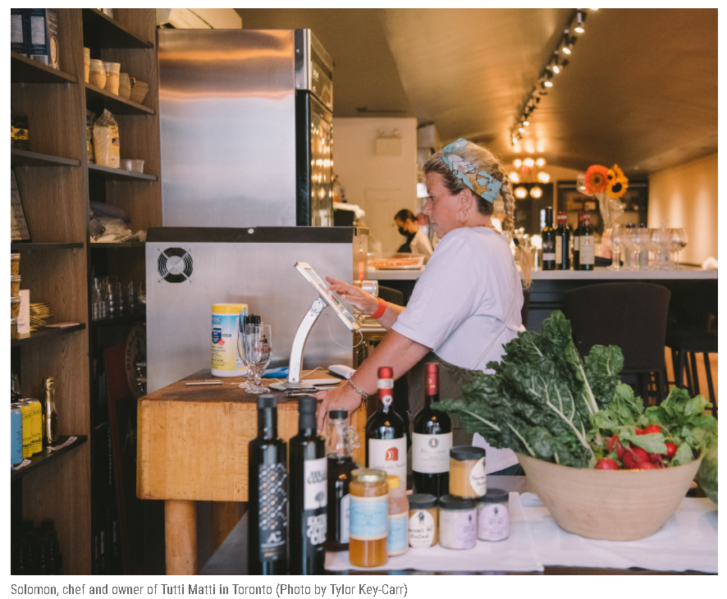The pandemic turned restaurants into grocery stores. Now that in-person dining is back, the industry could be forever changed.
Like many restaurateurs who focus on fresh pasta, Alida Solomon found that long strands of fresh, delicate noodles quickly congealed into clumps within delivery containers. It was clear that she needed to do more than transition her menu to off-premise sales by shovelling tagliatelle into the back seat of an Uber.
So, last year, the chef and owner of Tutti Matti in Toronto invested in an extruding machine to produce sturdier pastas such as canestri, rigatoni, bucatini and conchiglie. She also converted the dining area near the window into a retail space dominated by a stand-up display freezer for gelato; the tables were devoted to farmers’ market produce and baked goods. “The market makes me happy,” she says. “Because I get to share my obsession with seasonal vegetables.”
When COVID-19 forced restaurant owners around the world to suspend dine-in service, they had a choice: adapt or die. So they threw every idea at the wall: meal kits, frozen foods, wine from their curated lists (in jurisdictions that relaxed alcohol laws), virtual cooking classes and subscriptions for ice cream or pizza. Even Earls, a national restaurant chain, started selling groceries.
Most restaurateurs emphasized that packing their cuisine into plastic cylinders was not what they got into business for, and they couldn’t wait to provide a dining experience again. Now that they are able to do so, which of the past year’s necessary adaptations will they retain and what will be jettisoned?
In Montreal, Emma Cardarelli couldn’t wait to get rid of takeout and delivery at her restaurant Nora Gray. She did as soon as patio service resumed. “The experience we give, the level of service and the quality of food: this is something that only translates in the dining room,” says Cardarelli. “That’s our brand and how we made our reputation.”

While meal kits (such as whole roasted sea bream with black rice alla puttanesca, garlic brown butter and caper sauce) were a big part of Nora Gray’s survival over the past year, their production took up too much of the kitchen, and the staff’s time, to co-exist with restaurant service.
Cardarelli’s other restaurant, the more casual Elena, however, is continuing not just with takeout and delivery, but with a basement café transformed into a retail area with jars of tomato sauce, hot chili oil, honey, Caesar dressing and frozen pizzas. Some of Elena’s products are available through Brunette, a website that distributes sauces, oils, T-shirts and other merch from independent restaurants, mostly based in Montreal, New York and Toronto.
Ideally, a restaurant could grow its retail revenue stream beyond niche distribution to land their sauces on supermarket shelves. But scaling up production requires outsourcing. The arrangement, in which a third party mass-produces a customized version of your food and then adds your business label (for example, everything on the shelves at Trader Joe’s), is known as co-packing. The manufacturing side of food can be lucrative. But restaurants face challenges—testing recipes with the co-packer, haggling over the source of ingredients to keep costs down—to maintain quality.
“Restaurants are small businesses. Inherently, they’re not very strategic,” says Bruce McAdams, hospitality professor at the University of Guelph. “I think most [of them] are going to drift back to their core business.”
But McAdams does see some features of that business shifting. “One of the things diners may have been lulled into accepting is smaller menus,” he says. “Menus have decreased in size and options. That is not going to change at all.” In fact, that’s been happening over the past few years as restaurants have grappled with higher wages and a kitchen labour shortage that was a problem long before the pandemic.
Many restaurateurs also say a small victory in the last year has been the willingness of diners to adapt to digital ordering, not just for pickup and delivery, but within the restaurant. Vince Sgabellone, Canadian food-service analyst with the NPD Group, a market research firm, believes this, too, will survive the pandemic. “Which is wonderful on a number of levels for the restaurateur and the consumer.”
No one likes waiting to order when they’re hungry or for the bill when they’re done. Ordering and paying through a tablet or phone streamlines the dining experience for the customer. Restaurants can also operate with fewer staff—an essential need in this labour market.
Those who plan on continuing their businesses as some amalgam of restaurant and general store are doing it not merely because they have enough capacity to devote space to sales that happen outside peak dining hours, but because the practice has forged a deeper connection with the community. For some, being a place to buy bread on a day when hour-long queues snaked around the supermarket block made their business more integral to their neighbourhoods and more personal in the lives of their customers.
Solomon, for example, sees less money from retailing than dining. But she plans to stick with the hybrid. “This is now a part of who we are,” she says.
Article From: Maclean’s
Author: Corey Mintz

